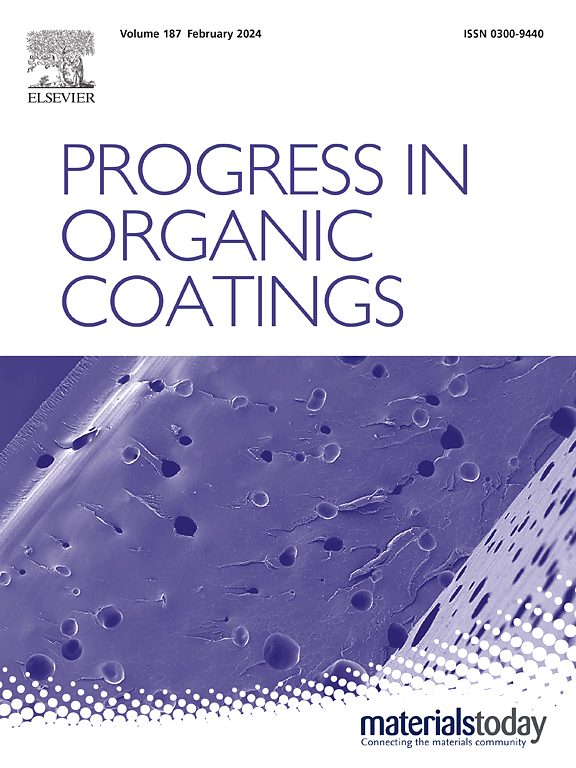Graphene/polyaniline waterborne composite coatings for metallic bipolar plates
IF 6.5
2区 材料科学
Q1 CHEMISTRY, APPLIED
引用次数: 0
Abstract
Waterborne composite coatings were formulated for protection of metallic bipolar plates. The challenges lied in two aspects, one was the confliction between high electrical conductivity and good corrosion protection properties; the other was the water dispersibility of the constituent phases. Water-solubility of polyaniline (PANI) were controlled by adding polystyrene sulfonic acid during the polymerization of aniline. Graphene was functionalized by p-aminobenzoic acid and p-phenylenediamine to enhance the compatibility with PANI, while keeping the electrical conductivity of graphene at around 169 S/cm. Upon in-situ polymerization of the functionalized graphene/PANI composites, the electrical conductivity varied significantly from 41 S/cm to 91 S/cm with the surface functionality of graphene. The composite coatings were prepared thereafter with functionalized graphene/PANI/carbon black on the surface of 316 L stainless steel by centrifugal spraying coating. The interfacial contact resistance of the coatings reached 4 mΩ·cm2, comparable to Au coatings, but the corrosion current density was 4.37 μA/cm2 due to the existence of the hydrophilic groups in waterborne coatings, like amino groups and sulfonic acid groups. A post-treatment was carried out to consume some of the amino groups, so that the corrosion current density was decreased to 0.88 μA/cm2.
用于金属双极板的石墨烯/聚苯胺水性复合涂层
为保护金属双极板配制了水性复合涂料。挑战在于两个方面,一是高导电性和良好的防腐蚀性能之间的矛盾;二是组成相的水分散性。通过在苯胺聚合过程中添加聚苯乙烯磺酸来控制聚苯胺(PANI)的水溶性。对氨基苯甲酸和对苯二胺对石墨烯进行了官能化处理,以提高石墨烯与 PANI 的相容性,同时使石墨烯的导电率保持在 169 S/cm 左右。在对功能化石墨烯/PANI 复合材料进行原位聚合时,电导率随着石墨烯表面功能的变化而从 41 S/cm 显著变化到 91 S/cm。随后,采用离心喷涂法在 316 L 不锈钢表面制备了功能化石墨烯/PANI/炭黑复合涂层。涂层的界面接触电阻达到 4 mΩ-cm2,与金涂层相当,但腐蚀电流密度为 4.37 μA/cm2,原因是水性涂层中存在亲水基团,如氨基和磺酸基团。通过后处理消耗掉部分氨基,腐蚀电流密度降至 0.88 μA/cm2。
本文章由计算机程序翻译,如有差异,请以英文原文为准。
求助全文
约1分钟内获得全文
求助全文
来源期刊

Progress in Organic Coatings
工程技术-材料科学:膜
CiteScore
11.40
自引率
15.20%
发文量
577
审稿时长
48 days
期刊介绍:
The aim of this international journal is to analyse and publicise the progress and current state of knowledge in the field of organic coatings and related materials. The Editors and the Editorial Board members will solicit both review and research papers from academic and industrial scientists who are actively engaged in research and development or, in the case of review papers, have extensive experience in the subject to be reviewed. Unsolicited manuscripts will be accepted if they meet the journal''s requirements. The journal publishes papers dealing with such subjects as:
• Chemical, physical and technological properties of organic coatings and related materials
• Problems and methods of preparation, manufacture and application of these materials
• Performance, testing and analysis.
 求助内容:
求助内容: 应助结果提醒方式:
应助结果提醒方式:


